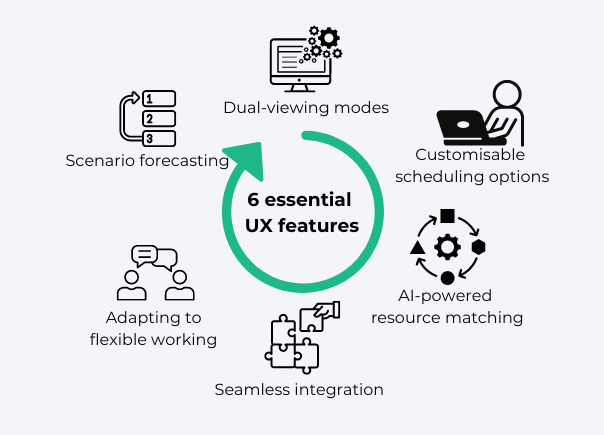When you’re planning resources and juggling multiple moving parts, the last thing you need is a hard-to-use resource scheduling tool. The trouble is, it’s easy to overlook the importance of user-friendly resource scheduling solutions, prioritising *shiny new things* like AI, over getting the basics of usability right.
But here's the thing: a tool that's simple to use and understand—yet highly sophisticated—can significantly boost your team's productivity and efficiency.
In this blog, we’ll explore how the right resource scheduling UX can bring real, tangible benefits to your team and projects.
Why user experience matters in resource scheduling
For resource planners and operations managers, the stakes are high. A tool that feels cumbersome or unintuitive (Excel anyone?) can slow down the scheduling process, introduce errors, and even impact team morale. Not exactly ideal.
On the other hand, a resource scheduling software designed with the resource planners in mind can:
- streamline workflows,
- reduce the learning curve,
- and improve overall project performance.
In people-based firms, where the allocation of human resources plays a critical role in success, the impact of UX is key. An intuitive scheduling tool, like Retain, helps teams easily match the right people with the right projects, considering their skills, availability, and development goals. This precision boosts project outcomes and contributes to employee satisfaction and retention.
The right UX turns a potentially daunting task into a seamless part of your project management routine. But before we get into what a great UX looks like, let’s briefly touch on the impact of a poor user experience on resource scheduling.
The impact of poor UX on resource scheduling
A bad user experience can have real, negative consequences on project management and team dynamics. One of the most common complaints we hear is about interfaces that are either too complex or just plain counterintuitive.
Your team ends up spending more time decoding the tool than actually planning resources. And let's not forget the ever-looming risk of errors. Incorrect data entries, overlooked resource allocations—it's a recipe for disaster.
Another challenge we often hear about is poor reporting or data visualisation capabilities. Without a clear visual representation of resource allocations and project timelines, making informed decisions becomes a guessing game.
The ripple effects of these UX nightmares are far-reaching. Miscommunication runs rampant as team members interpret and use the tool differently, leading to inconsistencies that can derail even the most well-planned projects.
And then there’s the toll it takes on team morale. Frustration with cumbersome tools can quickly turn into disengagement and decreased productivity. Over time, this leads to high turnover rates, as employees seek greener pastures where processes are smooth and streamlined.
Plus, it can affect client satisfaction, as delays and errors become more frequent. In the long run, this can tarnish a firm's reputation and affect its ability to attract and retain clients.
Benefits of excellent UX in resource scheduling
Shifting our focus to the brighter side, a resource scheduling tool with an excellent user experience actively contributes to a smoother, more effective project management process.
Here are just a handful of the key benefits:
Improved accuracy and efficiency
Firstly, a well-designed tool simplifies the process of entering and updating information, which significantly reduces the chances of errors. With features like real-time reporting and drag-and-drop scheduling, data is not only accurate but also reflects real-time changes. This accuracy is crucial for making informed decisions and avoiding the costly mistakes that can derail projects.
Increased adoption and engagement
When a tool is intuitive and easy to use, team members are more likely to use it to its full potential. This leads to better compliance with project management processes and standards. Moreover, when team members find a tool genuinely helpful, their engagement with the project and the tool itself goes up. This is a key driver of project success, as it ensures that all team members are on the same page and working efficiently towards common goals.
Higher overall satisfaction
A tool that caters to user needs can significantly enhance satisfaction levels among all team members. This satisfaction comes not just from the ease of use but also from the feeling that the tool genuinely supports their work. And when you feel supported at work it creates a positive work environment, boosting morale and productivity. Plus, happy teams are more likely to stay, reducing turnover rates and the costs of recruiting and training new employees.
More strategic decision-making
Beyond the day-to-day efficiencies, an excellent user experience in resource scheduling supports strategic decision-making. How? Well, with clear, intuitive interfaces and robust reporting features, the right tool provides insights into resource utilisation, availability, and project progress. Managers can use this data to make informed decisions about future projects, resource allocation, and team development strategies.
Improved client relationships
Finally, the benefits of a great user experience extend to client relationships too. With more efficient and accurate project planning, projects are more likely to be delivered on time and within budget. This strengthens client trust and satisfaction, leading to repeat business and positive referrals. Win-win.
Essential UX features to look for in resource scheduling software

So, now that we know the benefits of a good resource scheduling user experience, let’s take a look at some of the essential UX resource scheduling features:
1. Dual viewing modes for enhanced flexibility
Look for resource scheduling software tools with dual viewing options. For example, Retain provides a cell-based structure for those who prefer an Excel-like interface, and a plan view structure that allows for drag-and-drop scheduling. This resource scheduling flexibility aligns with user preferences and workflows. The plan view enables project managers to allocate resources to projects efficiently, either individually or in bulk, while the table view provides a familiar yet advanced interface for managing time allocations directly.
2. Customisable resource scheduling options
With a tool like Retain, features such as bulk duplications, splitting bookings, and applying different charge rates can be managed with ease. The tool’s ability to display crucial metrics like utilisation percentages, currency, and overall project health at a glance further enhances its usability, ensuring that project managers can make informed decisions quickly and in a way that meets their needs.
3. AI-powered insights for strategic planning
If you are keen to use AI, some tools also incorporate AI-powered recommendations. This feature suggests the most suitable resources for a project based on skills and work experience and also identifies potential matches that may be suitable based on similar criteria. This enables managers to optimise resource allocation, ensuring that the right people are working on the right projects, maximising efficiency and project outcomes.
4. Seamless integration and real-time notifications
Resource planning software, like Retain, also supports seamless integration with tools like Outlook, syncing resource schedules to calendars and ensuring that everyone is updated on changes to their schedule. This level of connectivity is essential in today's flexible working environments, allowing for real-time communication and alignment with both internal stakeholders and external clients.
5. Adapting to flexible working practices
The best tools align with modern, flexible working practices by offering around-the-clock resource planning operations accessible via a mobile app. This mobility ensures that resource management is not confined to the office, enabling managers and team members to stay connected and informed no matter where they are.
6. Future-proofing with scenario forecasts
Lastly, the ability to plan ahead with scenario forecasts allows for stress-free resource scheduling. Managers can anticipate and mitigate potential disruptions before they impact project timelines, ensuring a smooth operational flow.
Bottom line: Invest in software that supports instead of hinders resource scheduling. Match people to projects with ease. Create a positive working environment. And satisfy clients for years to come.
Selmi van Staden, Director – Audit Operations, Pitcher Partners, says it best; “I really like using Retain Cloud because it’s user-friendly, very flexible, and customisable to your own liking. The onboarding and set-up were quick, with only half a day needed to configure and get the data format right.”
Moving Forward: Harnessing UX for smarter resource scheduling
It's clear that the right resource scheduling tool can make a significant difference in how teams plan, execute, and succeed in their projects.
Tools like Retain are leading the charge, offering features and flexibility that far surpass traditional methods like Excel. With dual viewing modes, AI-powered recommendations, and seamless integration capabilities, these advanced tools make resource scheduling more intuitive, strategic, and aligned with individual and organisational goals.
Ready to learn more about resource scheduling software? Check out our overview of resource scheduling software or get in touch, to get started today.


